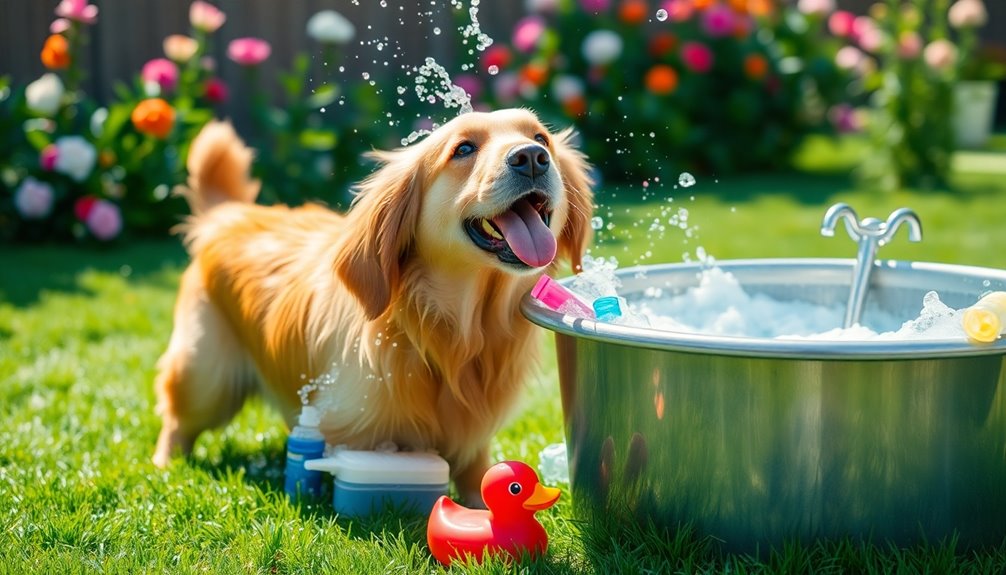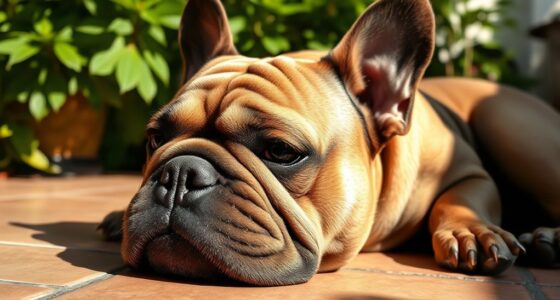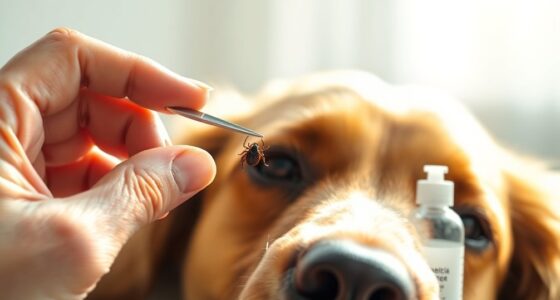Most dogs need a bath every 1 to 3 months, but factors like breed, coat type, and activity level can change that. Short-haired dogs may be fine with a bath every 2 to 3 months, while long-haired breeds often require bathing every 3 to 4 weeks. If your pup is very active or has a skin condition, you might find bathing is necessary more often, even weekly. Seasons matter too; summer may raise bathing needs, while winter can dry out skin. Keep an eye on their coat and skin health, and you'll discover more about ideal grooming practices.
Key Takeaways
- Most dogs benefit from baths every 1 to 3 months, depending on their coat type and lifestyle.
- Medium and long-coated breeds typically require baths every 4 to 6 weeks for optimal cleanliness.
- Active dogs or those with skin conditions may need weekly baths to maintain skin health.
- Adjust bathing frequency based on seasonal changes, with more baths in summer and less in winter.
- Monitor your dog's skin condition regularly, as changes may indicate the need for a different bathing routine.
Bathing Frequency Guidelines
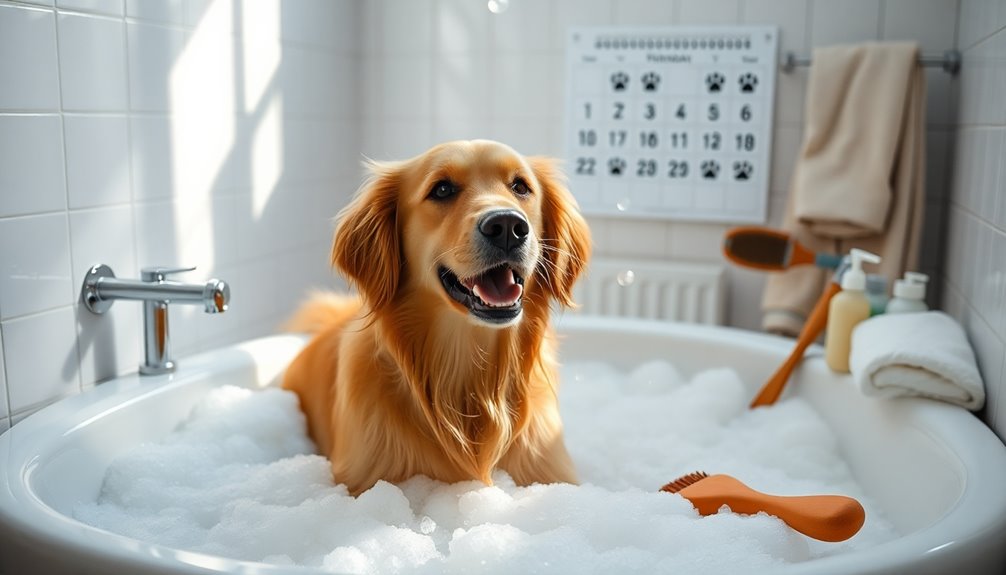
When it comes to bathing your dog, most canines need a bath every 1 to 3 months, but this can vary based on their breed and lifestyle.
Medium- and long-coated dogs usually benefit from baths every 4 to 6 weeks to prevent matting and maintain a healthy coat.
On the other hand, short coats might only need cleaning every 2 to 3 months or when they look dirty.
If you've got an oily coat breed, like a Retriever, you may need to bathe them more often to manage grease and odor.
Active dogs or those with skin conditions might require weekly baths to keep their coats clean and healthy, ensuring proper grooming and skin care.
Breed and Coat Considerations

Understanding your dog's breed and coat type is essential for determining the right bathing routine. Different breeds require different grooming schedules to maintain their health and skin care. Here are some key considerations:
- Short-haired breeds (e.g., Beagles): Typically need baths every 2-3 months.
- Long-haired breeds (e.g., Shih Tzus): May require baths every 3-4 weeks to prevent matting.
- Double-coated breeds (e.g., Labradors): Focus more on de-shedding than bathing to preserve natural oils in their coat.
Hairless breeds, like the Xoloitzcuintli, also need regular skin care with weekly baths.
Always research your dog's specific breed and coat type to confirm you're meeting their unique grooming and bathing needs for ideal health.
Health and Skin Factors
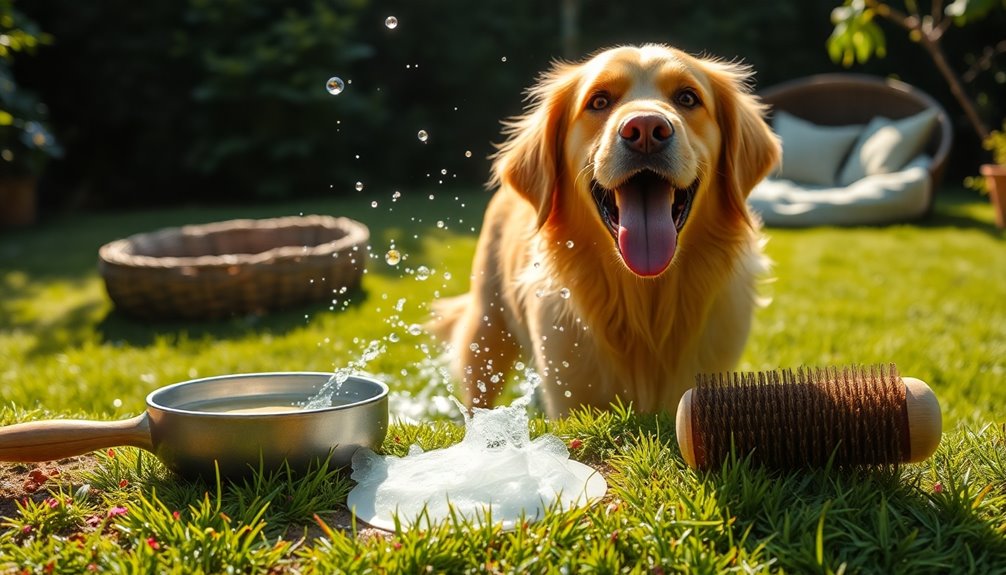
While your dog's breed and coat type play a significant role in their bathing needs, health and skin factors are equally important to take into account.
Dogs with skin conditions may need a customized bathing schedule, often requiring medicated shampoos prescribed by your veterinarian. Regular monitoring of your pup's skin health is essential; any changes could signal underlying issues.
Be cautious of over-bathing, as it can lead to dry skin and disrupt their natural moisture barrier. Always choose dog-specific shampoos with appropriate pH levels to protect their skin.
Additionally, incorporate grooming practices like regular brushing to maintain skin and coat health, manage shedding, and reduce the frequency of baths, keeping your pup comfortable and clean.
Seasonal Bathing Needs

As the seasons change, so do your dog's bathing needs.
During the summer months, you might notice an increase in bathing frequency due to skin allergies, parasites, and dirt from outdoor activities.
In contrast, winter can lead to dry skin, requiring you to monitor your dog's skin health and bathe them occasionally.
Here are some key points to reflect upon:
- Summer: Increase baths to combat skin allergies and parasites.
- Winter: Watch for dry skin and bathe less frequently, but still keep an eye on skin health.
- Dusty Environments: If your dog lives in a dusty area, regular baths year-round are essential to maintain cleanliness and skin health.
Adjust your routine based on these seasonal changes!
Lifestyle and Age Impacts

Your dog's bathing routine isn't just influenced by the seasons; lifestyle and age play significant roles too.
Puppies and young dogs typically need more frequent baths every 1-3 weeks due to their high activity level and tendency to get dirty. In contrast, senior dogs may need fewer baths but might require extra grooming assistance to maintain cleanliness, especially if they struggle with self-grooming.
If your dog has health conditions, like urinary incontinence, daily cleaning may be necessary. Long-coated breeds and active dogs exposed to muddy environments will also benefit from more frequent baths.
Frequently Asked Questions
Is It Okay to Bathe a Puppy Once a Week?
Yes, it's generally okay to bathe a puppy once a week, especially since they love to explore and can get quite dirty.
Regular baths help keep their skin healthy and reduce odors. Just make sure you use a gentle, puppy-specific shampoo to avoid irritation.
Keep an eye on their skin condition, though; over-bathing can strip natural oils, leading to dryness. If you notice any issues, consult your vet for advice.
How Often Should a Dog Be Bathed?
Bathing your dog's like juggling a delicate balance; you want them clean without stripping their natural oils.
Generally, you should bathe your pup every 2-3 months for short-haired breeds, while medium-haired ones benefit from every 4-6 weeks. Long-haired dogs may need baths every 3-4 weeks.
Active dogs or those who love mud might require more frequent baths. Just remember to brush them regularly to help them stay fresh in between!
What Happens if You Don't Give Your Dog a Bath?
If you don't give your dog a bath regularly, you might notice a buildup of dirt, oil, and dander, leading to unpleasant odors.
Neglecting hygiene can cause skin infections and irritations, making your pup uncomfortable.
Over time, accumulated grime can worsen existing skin conditions and hinder treatment effectiveness.
This poor hygiene can also affect your dog's overall well-being, potentially leading to behavioral issues like scratching or anxiety.
Keeping your pup clean is essential!
How Often Should I Dry Bath My Puppy?
Imagine a gentle breeze brushing over a freshly groomed field; that's the feeling you want for your puppy!
You should dry bathe your pup every few days to weekly, depending on how active they are. If they're prone to dirt and odors, consider more frequent sessions.
Just make sure to use pet-safe wipes that won't irritate their sensitive skin. Keep an eye on their skin's condition and adjust as needed for comfort.
Conclusion
To sum up, finding the right bathing frequency for your dog is key to keeping them clean and healthy. While you might worry about over-bathing stripping their natural oils, remember that it's all about balance. By considering your dog's breed, health, and lifestyle, you can tailor a routine that works for both of you. So don't stress—embrace your pup's unique needs, and you'll both enjoy the grooming process without any guilt!

